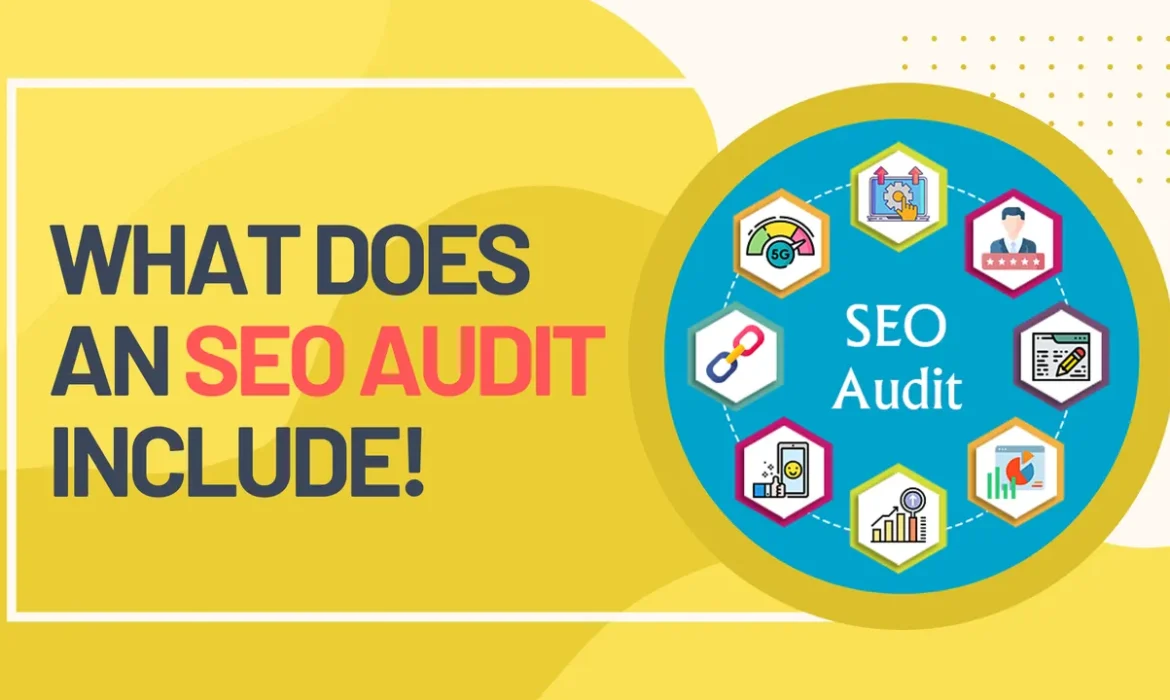
Are you tired of feeling like your website is stuck in a rut, invisible to your target audience and struggling to attract new customers? You’re not alone. It is not uncommon for businesses to invest significant capital and time into their online presence only to be disappointed with the results.
Despite their best efforts, they’re stuck on page 2 or worse of search engine results, watching their competitors outrank and outshine them. But here’s the good news: there is a solution: Conducting a comprehensive SEO audit.
Performing an in-depth SEO audit can help you identify and resolve the underlying problems holding back your site. In this article, we’ll take a deep dive into “what does an SEO audit include” so you can uncover hidden opportunities and transform your online presence.
What does a technical SEO audit include?
A comprehensive SEO review should begin with a technical SEO audit. It’s essential to ensure your website is crawlable, indexable, and easily accessible to search engines.
Think of it like a car inspection: you need to check the engine, transmission, and brakes to ensure the vehicle is running smoothly. Similarly, a technical SEO audit examines the underlying structure and mechanics of your website to identify areas for improvement.
Website crawling and indexing

To check for new and updated content on the web, search engines like Google use software programmes called crawlers or spiders. In order to ensure your website is crawlable and indexable, your technical SEO audit should include the following:
Crawl rate and frequency: How often does Google crawl your website, and how many pages are being crawled per day?
Indexation rate: What percentage of your website’s pages are being indexed by Google?
Canonicalisation: Are there any duplicate or variant pages that need to be canonicalised to avoid confusion?
Mobile-Friendliness and responsiveness

It is essential to optimise your website for mobile devices since most internet users access the internet from their mobile devices. A technical SEO audit should assess the following:
Mobile-friendliness: Does your website pass Google’s mobile-friendly test?
Responsiveness: Does your website adapt to different screen sizes and devices?
Page speed and performance optimisation

High bounce rates, low engagement, and poor search engine rankings can all result from a slow website. A technical SEO audit should evaluate the following:
Page load time: How long does it take for your website’s pages to load?
Page size and compression: Are there opportunities to reduce page size and improve compression?
Server response time: How quickly does your server respond to requests?
Read Also: The Impact of Page Speed on User Experience and SEO
SSL certificates and HTTPS
Websites with SSL certificates and HTTPS certificates are rewarded by Google with a slight ranking boost. A technical SEO audit should verify the following:
SSL certificate installation: Is an SSL certificate installed and configured correctly?
HTTPS implementation: Is HTTPS implemented correctly across the entire website?
XML sitemaps and Robots.txt files
A technical SEO audit should also review the following:
XML sitemap: Is a valid XML sitemap submitted to Google Search Console?
Robots.txt file: Is the robots.txt file configured correctly to allow or disallow crawling?
What does an On-Page SEO audit include?
An on-page SEO audit is a crucial step in understanding your website’s current SEO landscape. It identifies areas of improvement and opportunities for your online presence by examining every aspect of your website in detail.
Think of it as a thorough inspection of your website’s foundation, structure, and content.
Keyword research and analysis
Keyword research is a key part of on-page SEO. An on-page SEO audit should include:
Keyword gap analysis: Finding and analysing gaps in your keyword strategy and identifying opportunities to target new keywords and phrases.
Keyword clustering analysis: Analysing keyword clusters to understand search intent and identify relevant topics and themes.
Content analysis: Evaluating your content’s relevance, quality, and optimisation for target keywords.
Meta tags, titles, and descriptions
Meta tags, titles, and descriptions are essential for search engine rankings and user experience. An on-page SEO audit should evaluate the following:
Meta title tag analysis: Assessing the quality, uniqueness, and optimisation of title tags.
Meta description tag analysis: Evaluating the quality, informativeness, and optimisation of description tags.
Header tag analysis: Examining the use of header tags (H1-H6) to structure and organise content.
Header tags and structured content
Header tags, along with structured data, help search engines understand your content’s hierarchy and relevance. An on-page SEO audit should assess the following:
Header tag usage analysis: Evaluating the use of header tags to break up content and highlight key points.
Structured data analysis: Identifying opportunities to use schema markup to provide additional context and information.
Image optimisation and accessibility
Images can significantly impact page load times and user experience. An on-page SEO audit should review:
Image compression and optimisation analysis: Evaluating opportunities to compress images and reduce file size.
Alt tag and descriptive text analysis: Assessing the use of alt tags and descriptive text to ensure image accessibility and understanding.
Internal linking and anchor text
Internal linking is an important SEO practise that helps both website visitors and search engines to easily navigate your website from one content to another. An on-page SEO audit should evaluate the following:
Internal linking strategy analysis: Examining the effectiveness of your internal linking strategy.
Anchor text analysis: Evaluating the use of anchor text to ensure it’s varied, descriptive, and not over-optimised.
What does an Off-Page SEO audit include?
Building your website’s reputation and authority online is what off-page SEO is all about. It’s about creating a strong online presence that search engines can trust, and users can rely on. Think of it as building a strong reputation in your community: you need to be known, respected, and trusted.
Backlink analysis
The importance of backlinks in off-page SEO cannot be overstated. An off-page SEO audit should include:
Backlink profile analysis: Evaluating the quality, quantity, and diversity of backlinks pointing to your website.
Link equity analysis: Assessing the link equity passed from high-authority websites to your website.
Link velocity analysis: Monitoring the rate at which new backlinks are acquired.
Local SEO and NAP consistency
For local businesses, off-page SEO is critical for attracting local customers. An off-page SEO audit should evaluate the following:
NAP consistency analysis: Making sure your business’s name, address, and phone number appear consistently on the web.
Local citation analysis: Identifying opportunities to improve local citations and online directories.
Google My Business analysis: Assessing the optimisation and accuracy of your Google My Business listing.
Reviews and ratings
In order to build trust and credibility with potential customers, online reviews and ratings are essential. An off-page SEO audit should review the following:
Review analysis: Evaluating the quality, quantity, and sentiment of online reviews across various platforms.
Rating analysis: Assessing the average rating and distribution of ratings across various platforms.
Social signals and engagement
Social signals and engagement are important for building your website’s online presence and authority. An off-page SEO audit should evaluate the following:
Social signal analysis: Monitoring social signals such as likes, shares, and comments across various platforms.
Engagement analysis: Assessing the level of engagement and interaction with your website’s social media profiles.
SEO audit report and recommendations
In an SEO audit report, it will include a detailed summary of your findings, opportunities, and recommendations for improvements. It’s a roadmap to enhance your website’s SEO, driving more traffic, and increasing conversions.
SEO audit report
A thorough SEO audit report should include:
Executive summary: A brief overview of the audit’s findings and recommendations.
Technical SEO analysis: A detailed analysis of the website’s technical foundation, including crawlability, page speed, and mobile-friendliness.
On-page SEO analysis: An evaluation of the website’s on-page elements, including title tags, meta descriptions, and header tags.
Off-page SEO analysis: An assessment of the website’s off-page elements, including backlinks, local SEO, and social signals.
Content analysis: An evaluation of the website’s content, including quality, relevance, and optimisation.
SEO Recommendations
The SEO audit report should also include a prioritised list of recommendations for improvement, including:
High-priority recommendations: Critical issues that require immediate attention, such as technical SEO issues or content gaps.
Medium-priority recommendations: Important issues that should be addressed in the short-term, such as on-page SEO optimisation or local SEO improvements.
Low-priority recommendations: Nice-to-have improvements that can be addressed in the long term, such as content refreshes or social media optimisation.
In Conclusion
Conducting a comprehensive SEO (Search Engine Optimisation) audit is the first key step in understanding your website’s strengths, weaknesses, opportunities, and threats. It’s not a one-time task but rather an ongoing process that should be repeated regularly.
Regular SEO audits are essential because search engine algorithms are constantly evolving. These changes can impact the visibility and ranking of your website in search results.
By conducting frequent audits, businesses can stay ahead of the curve and adapt their strategies accordingly, gaining a competitive edge in the search landscape.
Frequently Asked Questions (FAQs)
What is an SEO audit?
It is a process that analyses a site’s technical, on-page, and off-page elements to find areas for improvement and opportunities for growth.
Why do I need an SEO audit?
An SEO audit is a valuable tool that helps you find out the strengths, weaknesses, opportunities, and threats of your website.
How often should I conduct an SEO audit?
Conducting an SEO audit twice a year or whenever your website undergoes significant changes is recommended.
What are the different types of SEO audits?
An SEO audit can be classified into three types: technical, on-page, and off-page.
What tools do I need to conduct an SEO audit?
A number of SEO audit tools are available, including Screaming Frog, Ahrefs, SEMrush, and Moz Pro. For your SEO audit, you can also use Google Search Console and Google Analytics.
How long does an SEO audit take?
It depends on the complexity and size of your website. On average, an SEO audit can take anywhere from a few hours to several days or even weeks.
Can I conduct an SEO audit myself?
Yes, if you have the expertise and the right tools, you can perform an SEO audit on your own. However, if you’re not well-versed in SEO, it’s best to get assistance from a professional SEO agency to handle the audit. This ensures that the audit is thorough and effective.